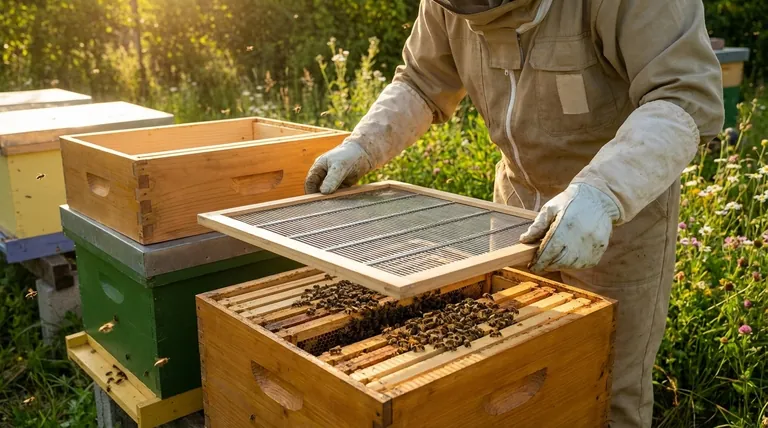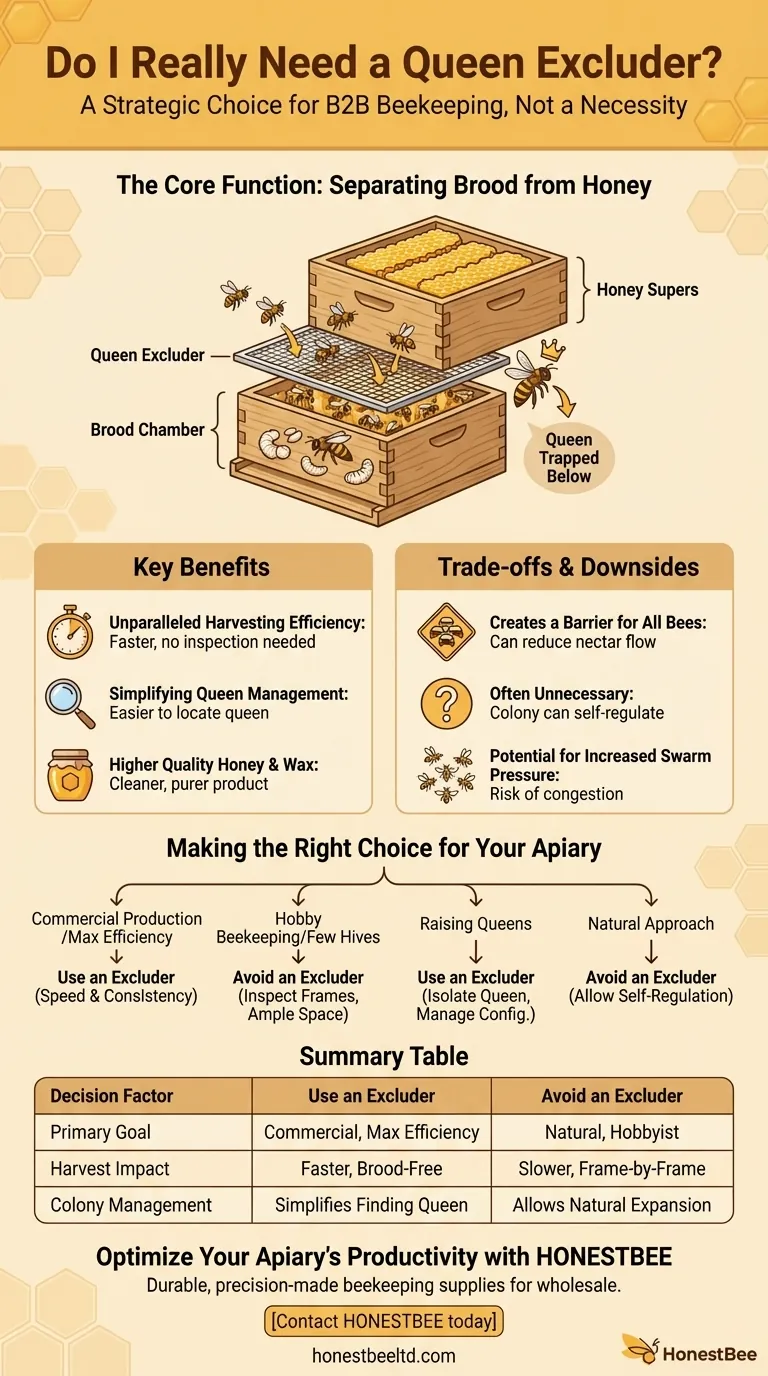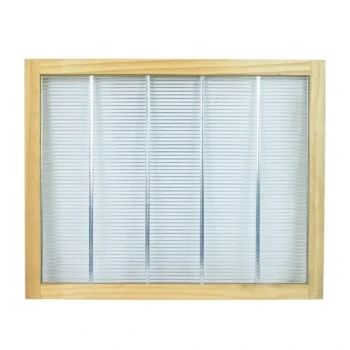No, a queen excluder is not an absolute requirement for beekeeping. It is an optional management tool, and estimates suggest that less than half of all beekeepers use one. Its primary function is to create a physical barrier that confines the larger queen to the brood chamber, preventing her from laying eggs in the honey supers while allowing smaller worker bees to pass through freely.
The decision to use a queen excluder is a strategic choice, not a necessity. It forces a clean separation between brood and honey, trading the benefit of maximum harvesting efficiency for the potential cost of impeding the natural flow of the colony.

The Core Function: Separating Brood from Honey
A queen excluder is a simple but precise piece of equipment. Its value is rooted in its ability to enforce a specific structure within the hive, which has direct consequences for honey harvesting.
What Is a Queen Excluder?
A queen excluder is a flat grid, typically made of metal or plastic, with openings that are precisely gauged. These openings are large enough for worker bees to move through but too small for the queen's larger thorax.
When placed between the brood boxes and the honey supers, it effectively traps the queen in the lower part of the hive.
The Primary Goal: A Brood-Free Harvest
Without an excluder, a queen is free to move into the honey supers and lay eggs. This results in frames containing a mix of honey, pollen, and brood (eggs and larvae).
Using an excluder ensures that frames in the honey supers contain only honey. This prevents brood from being accidentally crushed and contaminating the honey during extraction, leading to a cleaner final product.
Key Benefits of Using an Excluder
For beekeepers who prioritize efficiency and predictability, the excluder is an invaluable tool.
Unparalleled Harvesting Efficiency
This is the single greatest benefit, particularly for commercial beekeepers. With an excluder, every frame in a honey super can be removed for extraction without inspection.
This eliminates the time-consuming process of checking each frame for the presence of brood, dramatically speeding up the harvest process.
Simplifying Queen Management
By confining the queen to a specific area (the brood boxes), she becomes much easier to find.
This is a significant advantage when you need to perform inspections, check for disease, or replace an aging queen.
Higher Quality Honey and Wax
Frames that have never contained brood are cleaner. They have less pollen and "travel stain," resulting in purer honey.
Furthermore, the honeycomb wax rendered from these frames is often of a higher quality and is less attractive to pests like wax moths.
Understanding the Trade-offs and Downsides
While efficient, imposing this artificial barrier on the colony is not without its disadvantages.
It Creates a Barrier for All Bees
The excluder is an obstruction. While workers can fit through, they must slow down and squeeze through the grid. This can create a "traffic jam" that may reduce the overall efficiency of honey storage, especially during a heavy nectar flow.
Some beekeepers mitigate this by providing a small upper entrance above the excluder.
It's Often Unnecessary
A queen excluder is often a solution to a problem that doesn't exist. In a hive with ample space in the brood chamber (e.g., two deep brood boxes), a healthy queen will typically stay there to lay her eggs.
Many colonies naturally maintain a compact brood nest and will not move up to lay in the honey supers unless they run out of room below.
Potential for Increased Swarm Pressure
Confining the queen can make the brood nest feel congested more quickly. This feeling of being "honey bound" or crowded is a primary trigger for swarming.
A beekeeper using an excluder must be especially vigilant about managing space in the brood chamber to prevent the colony from swarming.
Making the Right Choice for Your Apiary
The decision to use a queen excluder should be based entirely on your beekeeping goals and management style.
- If your primary focus is commercial production or maximum efficiency: Use an excluder, as it dramatically speeds up harvesting and ensures a consistent, brood-free product.
- If your primary focus is hobby beekeeping with a few hives: You can likely manage without one by carefully inspecting frames before harvest and ensuring the queen has ample room below.
- If your primary focus is raising queens: An excluder is an essential tool for isolating the queen and managing specific hive configurations.
- If your primary focus is a more "natural" beekeeping approach: Avoid the excluder and provide ample space to allow the colony to self-regulate its brood nest.
Ultimately, observing your colony's specific behavior is the most reliable guide to making an informed decision.
Summary Table:
| Decision Factor | Use an Excluder | Avoid an Excluder |
|---|---|---|
| Primary Goal | Commercial production, maximum efficiency | Natural beekeeping, hobbyist approach |
| Harvest Impact | Faster, brood-free harvest for pure honey | Slower, requires frame-by-frame inspection |
| Colony Management | Simplifies queen finding; risk of congestion | Allows natural colony expansion; less swarm risk |
Optimize Your Apiary's Productivity with HONESTBEE
Whether you manage a large commercial apiary or supply beekeeping equipment distributors, the right tools are crucial for success. A queen excluder is a key decision that impacts your harvest efficiency and honey quality.
At HONESTBEE, we supply durable, precision-made beekeeping supplies and equipment through our wholesale-focused operations. Let us help you choose the right tools for your specific goals.
Contact HONESTBEE today to discuss your needs and discover how our equipment can help you achieve a cleaner, more efficient harvest.
Visual Guide

Related Products
- Premium Wood Framed Metal Wire Queen Bee Excluder
- Plastic Queen Bee Excluder for Bee Hive Wholesale
- High Performance Plastic Queen Excluder for Beekeeping and Apiary Management
- Professional Plastic Queen Excluder for Modern Beekeeping
- Metal Queen Bee Excluder for Beekeeping
People Also Ask
- Can a queen get through a queen excluder? A Guide to Preventing Hive Failures
- What are the advantages of using queen excluders? Boost Honey Production & Hive Management
- What are the advantages of using a queen excluder? Maximize Honey Yield & Hive Control
- What is the primary function of a queen excluder? A Guide to Brood-Free Honey Harvesting
- What makes polyurethane foam environmentally friendly? The Surprising Benefits of a Durable, Inert Material



















